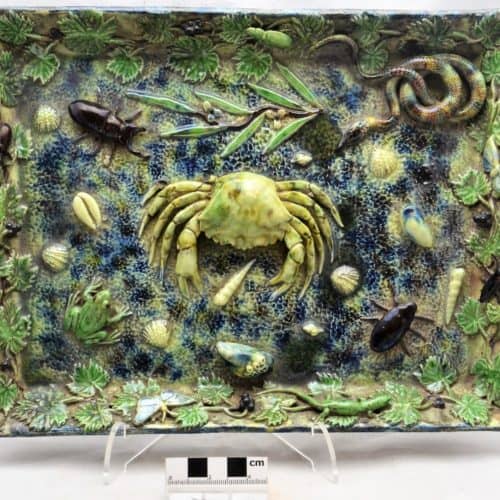Cabinets of Curiosity activity 2: Tudor Palissy dish of Folkestone wildlife
Investigate the rustic-ware ceramics of French Tudor potter Bernard Palissy, with his raised designs of sea creatures, reptiles, butterflies and flowers: Learn with Objects Cabinets of Curiosity 4: pottery.
Explore the wider theme of animals in art with some great ideas from the Tate.
The children are then set the challenge to discover wild animals, insects and flowers living in habitats near Folkestone and to include them in their own piece of rustic-ware or other art form.
Learning objectives
Increased knowledge and understanding of animals in art, local wildlife and the work of ceramic artist Bernard Palissy.
Skills in creating a piece of art inspired by the work of Bernard Palissy.
Curriculum links
KS1-4 Art and Design (animals in art, different media, history of art)
KS1-2 Science (living things, wildlife, insects, habitats)
Set the children the challenge to find images of more rustic-ware designs by Bernard Palissy and to discover more about his life.
Which other artists have been inspired by wildlife?
Look at some of their work too.
There are some excellent resources and ideas for creative activities in the classroom from the Tate.
https://www.tate.org.uk/art/teaching-resource/animals-art
Ask the children to think of some of the special wild places (habitats) near Folkestone, and to research some of the animals and plants that live there.
There are many special habitats that can be used for inspiration from the Kent Downs, East Wear Bay and The Warren, to Samphire Hoe, the Romney Marsh, Royal Military Canal and Dungeness.
Some of the websites below are good for finding out about different habitats and species.
https://www.kentwildlifetrust.org.uk/wildlife-explorer
http://www.royalmilitarycanal.com/pages/wildlife.asp
https://www.kentdowns.org.uk/visit/
http://www.samphirehoe.com/uk/biodiversity/wildlife-species/
Inform the children that they are going to create their own platter, like Bernard Palissy, but inspired by wildlife near Folkestone.
They can copy and save reference images of different creatures, plants and flowers they’d like to include on their dish.
Ask the children to work up a rough design on paper first, so they are happy with where the different elements are going to go. We suggest they work to A4 or A3 size.
Unless you have access to a kiln, it might be easiest, and most affordable to make the platters from corrugated cardboard, which can be covered in paper and painted.
The animals and plants, which will be raised in relief, can be made from self-hardening clay or papier-mache, which can be painted and stuck on to the platter when dry.
The class might also like to experiment moulding some items in air drying clay, small hollow shells for example or leaf impressions.
Materials needed:
- A3 or A4 paper
- cardboard
- newspapers
- glue
- air-drying clay
- shells and leaves for modelling
- poster paint
- scissors
Learn with Objects links
See Cabinets of Curiosity Topics: 2, 4, 8 and 10 for inspiration.

